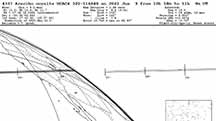
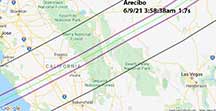
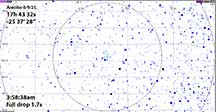
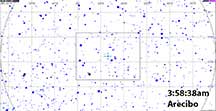
BLM map, showing the campground at hilltop about a mile off of San Ardo - Lockwood Rd, at the ridge.
David Dunham sent a notice on June 7 that this asteroid had just been observed with some confidence by two observers in Australia as a binary asteroid. These are few enough to make this a valuable thing to verify. The first chance is June 9- as the asteroid occults a decently bright star visible only from California and Nevada before twilight. Could be a real nice bit of science... if I can sacrifice the sleep.
The main occultation is apparently high rank (but then, could it really? If it's a previously unknown binary, that will affect the center of light of the object. However, the moonlet is roughly half the main body and was observed to be in the same path as the main body at the time of the occultation.
The center latitude at long 121 00 00 is 35d 51' 37". This goes essentially right through Williams Hill BLM campground. It's about a 6 mile drive off the San Ardo exit off 101. It's about a 2hr 30 min drive each way, and 220 miles round trip. In the end, I decided not to pursue the extra distance and time to get to this campground - we'll save that for another adventure.
 |
 |
 |
 |
BLM map, showing the campground at hilltop about a mile off of San Ardo - Lockwood Rd, at the ridge. |
|
Cloud cover looks to be 10-20% at event time, thin high clouds. Probably not a killer for this bright star (they were not an issue; invisible) |
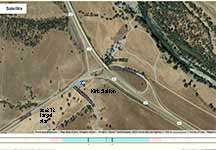 |
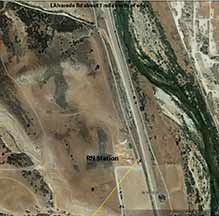 |
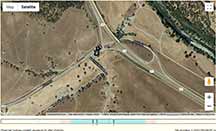 |
Couldn't ask for better results! Kirk and I both got good data and not only recorded the main body, but also both of us got occultations of the satellite recently discovered by Dave Gault and Peter Nosworthy in Australia. Here's Dave and Peter's webpage on this discovery observation in Australia via occultation and here's the link to a new paper in press at Astronomy and Astrophysics announcing Solar System discoveries from the GAIA DR3 release, with 2 full pages of analysis on the discovery of this moon of Arecibo (Tanga et al. 2022)
Nolthenius Results
I used the 4x setting on the Watec (15 integrations per second). There was obviously flickering, the stars seems to focus tightly and so even at this dim magnitude and low altitude, 4x was good enough to keep a steady view of the star. There were no clouds that I could see, and no wind.
|
I set up at the entrance to a ranch off a frontage road of Hwy 101. |
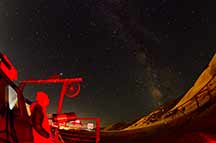 |
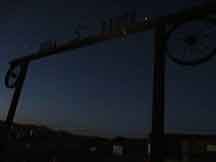 |
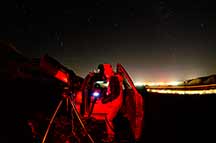 |
|
The slender 0.86% waning cresent moon was to rise in strong twilight. I hoped to see it and take a bunch of photos and try to pull the difficult to see razor thin crescent out of the bright twilight in Photoshop. But no matter the Photoshop'ing, I could not get it to come out. |
I took some footage of the globular cluster M22 at 64x integration, after the occultation. |
A decent version of a "hero shot" for me at this event. |
|
I first got the light curve from LiMovie. This is the entire record |
My LiMovie recording, zoomed in on the events |
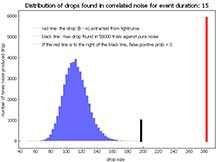 |
I then re-analyzed with PyMovie and here's the PyOTE solution for the satellite |
Bender Results
Kirk observed from a parking area for trucks off Jolon Rd where it intersects Hwy 101, the southern intersection (not the one near King City). He used the 4x setting for the Watec 910hx and photometry using PyMovie and analysis using PyOTE.
|
Kirk's PyOTE light curve, zoomed in |
Our sky plane plot shows the binary asteroid nicely
Dave Gault wrote an announcement of this discovery for the Central Bureau for Astronomical Telegrams